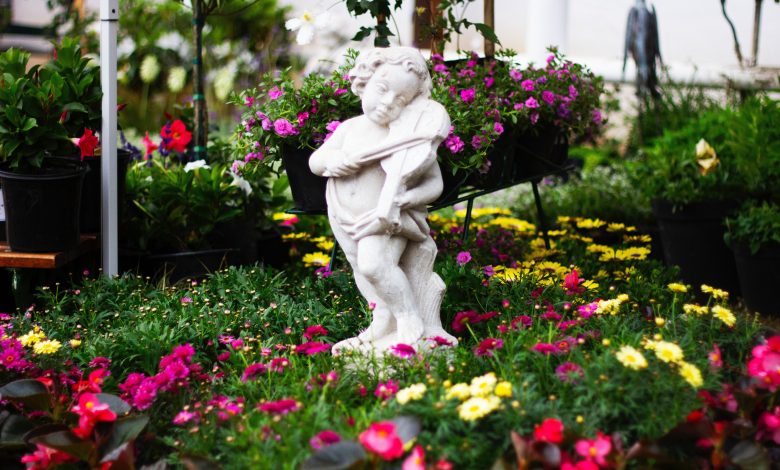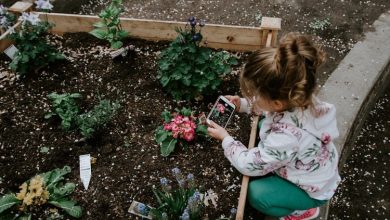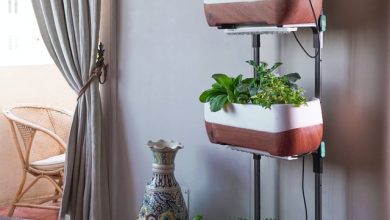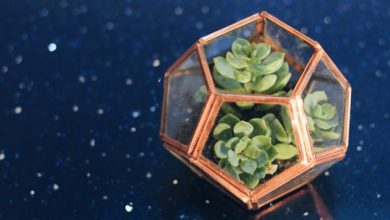Using Creativity in Your Garden Design

Your garden is a blank canvas, waiting for you to transform it into a naturalistic work of art. Whereas painting is limited to one dimension, your garden has multiple. You can appeal to a variety of senses and use plants, color, decoration, and furniture to create a living painting that you can explore.
The intention of this article is to try and stoke that little creative flame that lives inside us all, and in doing so, get you thinking about just how you want to create your masterpiece.

Water
One of the biggest advantages a gardener has over other artistic or creative hobbies is that they have an easier time stimulating all of the senses, so it would be incredibly short-sighted to not take advantage of this.
Sound, for example, is a tool you have at your disposal that can elevate your garden beyond what flora alone can do for it. Picture the scene: it’s a gloriously sunny day, with a bright blue sky and not a cloud in sight. Your garden is beaming with color and life, and the sound of a waterfall gently trickling can be heard faintly among the chorus of chirping birds.
Sounds great, doesn’t it? You can achieve this level of ambiance by installing a small waterfall in your garden. You build one yourself if you don’t want to splash the cash for it, although then your options are limited.
If you do decide to buy one, you get a good choice of styles and sizes. You can get an ornamental Zen piece with eastern influences, or a statue fountain with imagery rooted in western religion. Just make sure that it complements the overall feel of the rest of your decoration.
If you have the space, budget, and skill, you could also dig a small pond. This is a fantastic addition to larger gardens and can serve as a strong anchor point to build everything else around. You can even consider adding some fish, like koi, to the water if you want to go above and beyond.
You might combine the two and have a fountain that runs into a lake. A piece like that is bound to run you a pretty penny, though, so if you don’t plan on breaking the bank for your garden project, then don’t get your hopes up.

Stone
Stone is essentially the polar opposite, yet it goes hand in hand with water elements in your garden.
When talking stone, we’re talking things like construction and structures and objects made from concrete that make up the skeleton of your garden. This includes any walls you may have, or even paths and pavement.
It’s one of the features of a garden that people notice first. A well-cut cobblestone pathway through your garden tends to stick in the mind of guests and is sure to impress.
If you’re unlucky enough to have large grey walls surrounding your little slice of heaven, as opposed to fencing, fear not! There are ways to cover it up and make it more visually appealing.
Obviously, you can paint it, but that’s not very creative at all. Instead, consider growing some wall climbers on them. It helps hide that ugly dullness, while not just replacing it with something else uninteresting.
As mentioned above, paths are an aspect of a garden that can really make or break the whole design. An embedded stone path that runs through your garden needs to be done with nuance and care. Don’t just have a line of grey. Zig-zag the placements, and break it up into individual steps instead of a single block. Remember, you want to use these man-made features to heighten the natural beauty, not destroy it.

Statues
While you could technically count these among the stone parts of your garden, it really deserves a section all of its own.
Statues are one of the more difficult parts of a garden to include or pull off, even more so than stone. The issue is that using them poorly results in a cluttered, ugly, and worst of all, tacky looking garden. Used right, though, and it continues to push that fantasy-like atmosphere that you should be trying to create.
The good part about statues is that you have a near-unlimited array of designs and types to work with, and if you have the money, your options truly are limitless.
You have your typical statues, like a cupid fountain or a buddha Zen, but there is also more unusual stuff that you can pick up, like small stone foxes and rabbits to litter the ground with.
What you buy should directly reflect the style you’re going for with the garden. You shouldn’t be adding a little diapered angel to an eastern-inspired oriental garden, and so on.
You also shouldn’t be using it as a centerpiece for the garden. Use it as enhancement only. Let the natural beauty of the flora and the atmosphere speak for the effort you have put in, not some statue you bought from the store.
Of course, if you have the dough, you can always get a statue made. You can get exactly what you want, but of course, this type of thing doesn’t come cheap. Although, if you’re looking for something very specific, it may be worth it to invest. You can get something made to your exact specifications, so if you want your garden to be perfect, it may be worth your while.

Birds
Not only should you be looking to capitalize on flora and other growable flowers, but living creatures as well.
For example, you could tie this into statues and get a birdbath. It’s unobtrusive and can help draw some little birds towards your garden.
Birdhouses are a good choice for decoration, too. Just make sure you maintain it if you do get one; otherwise, the elements can wear it down to the point that the wood is rotten, and there is no saving it.
You can also use a bird feeder, either one you’ve bought or a homemade one. Hang it up from a tree or off a wall, and watch as your garden comes alive. Be careful, though; if you grow and plant what a bird might eat, then you may want to give this a miss.
Bringing birds into your garden continues to build on those sensual experiences that were mentioned earlier. Their chirping combines beautifully with the sound of flowing water to create a melody that can make your garden almost seem otherworldly.

Flower Designs
This encapsulates what you plant, where you plant it, what you plant next to what, and why you plant it. It’s a good idea to know what you want to do with your garden in advance before you go planting anything. It helps you stay neat and tidy and stops your garden from looking like an unorganized mess.
For example, you could choose to plant solid colors exclusively. This type of design is quite bold and allows you to pull off some spectacular looking pieces, but it needs to be done tactically. You have to contrast certain colors with others so that one batch doesn’t dominate and that each flower compliments and contrasts well with its neighbors.
A foundational understanding of color theory and the principles of design wouldn’t go amiss here, so if you have that kind of knowledge, be sure to use it.
Alternatively, you could go with something more intricate. Rather than just using solid colors, you could plant something with a pattern and a bit more flair.
You could have a circular patch of violets, let’s say, and run a thin ring of marigolds around them, or you could use flowers to create interesting shapes on your garden floor, rather than just a bush or a circle. It requires a lot of maintenance and effort, but when done well, it looks really great.
You also need to consider using hanging baskets around your garden. It isn’t a feature that suits everything, but if you’re growing something like strawberries, it can be a nice little addition to hang off of some wall mounts.
You need to watch out for birds if you are planting berries, though, as the little critters eat them like there’s no tomorrow. So if that’s an issue for you, consider purchasing some netting to throw over your berry bushes.

Draw A Map
You should be drafting up not just one, but multiple maps as you go along with the gardening process. Plan out your garden well before you put seed to soil, or stone to soil, if you can. Your maps can have whatever details you want on them, but the more in-depth you go, the more your garden benefits.
Include your garden’s skeleton structure, meaning all things stone, walls, paths, sheds, patio, and so on. Doing this gives you a feel for the natural flow and shape of your garden, which is ultimately something you need to work with and compliment to get the most out of your efforts.
Also, use this map to plan out where you want to plant each flower. As you know, different plants need different conditions to thrive. Some like the shade, while some like the high noon sun, so by planning out in advance on paper what goes where, you avoid getting some nasty surprises down the road when your flowers refuse to grow for you.
You can also use this process to visualize how certain color combinations work and interact. As well as where your flowers go, consider how it’s going to look when everything is in full bloom. Are the colors going to complement one another or contrast nicely? Or is it going to be jarring and an eyesore? These are things you need to consider.
Lastly, you can use this process to plan out how you want to partner your plants and what neighbor plants you’re going to use. This means, what types of plants are you using to repel pests, insects, and the like? There are plenty of unobtrusive herbs and flowers that perform this function, so invest in them and keep your showpieces safe.

Arches and Pergolas
It’s not a design feature that works for everyone – bear that in mind. You need to have the space to make it work, but if you’re lucky enough that you do, it would be a disservice not to take full advantage of them.
The structures have several uses. Of course, it looks great and can be used just as an extra something for the eye to explore. Or you can think more tactically and use them to break up your garden and section certain parts off. This allows you to control your viewer’s eye, drawing it into a bundle of features that you want them to explore away from the rest of the garden.
To this end, you could even combine your arch with a hedge or a wall. Again, you need the space for it, but it works fantastically if you do.
As for what type to get, generally, you are going to be working with wood. If you have the carpentry skills yourself, you could make one at home in your workshop. Otherwise, you’re going to have to get one delivered.
There is a myriad of different designs you can get, each ranging in price. There are square arches with overhangs and crisscrossing beams along portions of the wall, or there are simple, circular designs that follow a natural curvature.
Where you really have room to shine with this, though, is in growing certain flowers on these arches. There are plenty of climbing flowers that can weave their way around whatever you plant them by, and arches are no exception. The flowers can end up covering your arch head to toe with color and life and turn what was a simple partition into something resembling a door to wonderland.

Patios
This doesn’t just include patios, but things like decking as well. Essentially, it is any aspect of your garden that is separate from the natural part of it.
It’s a relatively simple design aspect, but one that can be quite expensive and requires a great deal of effort and consideration.
Firstly, think about where you want to put it. Above, we mentioned how these kinds of aspects are normally separate from where you’re growing your flowers. This is true, but not a universal truth. You could create a piece right in the middle of your lawn, but it works better if it is at the center of your garden or in its own little space.
Then, you should be thinking about design. Namely, do you want to go with some stone paving or wooden decking? Each has its advantages, and what you use should depend on the rest of your garden. If you have a lot of stone decoration, walls, paths, and so on, go with paving to compliment that, but if you have wooden structures, obviously work with wood instead.
The importance of this kind of area in your garden cannot be overstated. Not only does it give you a practical area to relax outside, but it gives you an area for your guests to sit down and admire all your hard work and effort.
To this effect, you need to be plotting out where you put this strategically. You want it to serve almost as a viewing platform for the rest of your garden, so put it in a spot that helps to highlight that.



